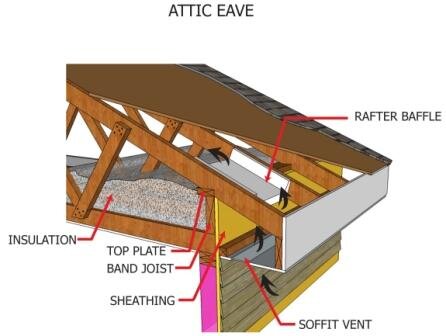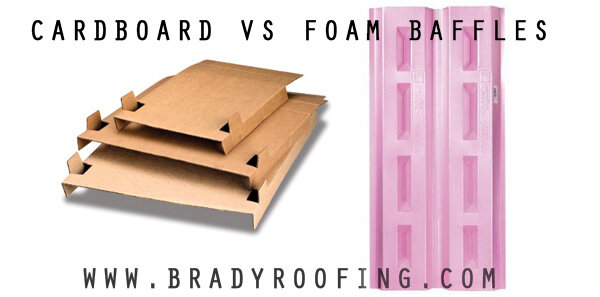How to Maintain Proper Venilation While Insulating Your Attic Using Baffles
 While it may seem counterintuitive, even well-insulated attic spaces require air circulation, which means pulling air from outside the home and allowing it to push through the attic to an exit point. Baffles provide a space for air to flow through certain parts of the attic. Baffles are also called wind baffles, venting chutes, rafter vents or insulation baffles. An attic needs to be insulated to keep your house warm in the winter and cool in the summer. When you have insulation without ventilation, humidity and moisture can build up in the top of your home causing mold and decay.Why baffles are important Baffles are used to maintain an air space between intake vents and exhaust vents under the roof system. Ice dams are formed by heat escaping through the roof and water from melted snow freezing as it passes the insulation at the eave. To reduce this problem it is necessary to push the insulation as far into the eave space as possible and the baffles allow this to happen without blocking the vents.The eave air intake vents are for the purpose of helping excess moisture to escape from the attic as it exits at the ridge vent. The amount of airflow through the eave vents is unlikely to be enough to have a substantial effect on the temperature of the roof, so put the baffles where they will allow the most air movement.Check to see if your house has eave vents, if it does then you should install baffles before insulating. Baffles ensure that insulation doesn’t block the vents, because attic ventilation is very important in reducing heat and moisture build up. To properly ventilate an attic, 50% of the ventilation should come from low on the roof (generally the soffits) and 50% from high on the roof line (generally the ridge) where the hot air can escape the roof.Calculating your Ventilation Note that it is important to check your local building code requirements to confirm the specified ratio for ventilation. There is a general rule that says there should be 1sq ft of ventilation for every 300 sq ft of attic floor space. For example, a 1600 ft² area would require 5.33 ft² or 768 sq in of ventilation, (1600/300*144). Half or 384 in² needs to come from low on the roof and 384 in² coming from high on the roof. It is OK to have more intake (low on the roof) than exhaust (high on the roof) BUT, it is not good to have more exhaust than intake.Think about what happens when you try to ventilate a space by opening a window. If you open just one window, not much happens. If you open a second window across the room, you get a breeze. This same principle applies to the attic. Even adding more vents higher in the attic wouldn’t balance the airflow, because the roof won’t vent any more air than is introduced by the low vents.Installing Baffle InsulationThe great thing about installing attic baffles is that they have a big impact on the effectiveness of your insulation and can be done without any specialized contractor tools. They can be installed with a few staples. I found this great video by Mr. Hardware installing attic baffles. [youtube id="5DX25Vz2jDc " width="600" height="350"] It’s not expensive, it is very effective, and did I say cheap! If you want to install the baffles yourself you can purchase them from Home Depot 70 pieces for $86.15. If you don't want to go through the hassle of installing them yourself we recommend a really good company who will install them for you: Hansen/All Seasons Insulation. Be sure to check your baffles yearly for damage, replacing any damaged baffles as you find them. You can extend your roof’s life for many years with proper ventilation.Cardboard vs. Foam Attic BafflesThe two most common attic baffles are made of cardboard or foam. They are manufactured to fit either 16 inch or 24 inch on center construction. Cardboard baffles are less durable but can be bent and cut to cover the end of the eave. This does a passable job of directing wind up the baffle and nothing to seal the top of the drywall. Foam baffles are more durable but are a straight section that cannot be bent or cut to fit easily.
While it may seem counterintuitive, even well-insulated attic spaces require air circulation, which means pulling air from outside the home and allowing it to push through the attic to an exit point. Baffles provide a space for air to flow through certain parts of the attic. Baffles are also called wind baffles, venting chutes, rafter vents or insulation baffles. An attic needs to be insulated to keep your house warm in the winter and cool in the summer. When you have insulation without ventilation, humidity and moisture can build up in the top of your home causing mold and decay.Why baffles are important Baffles are used to maintain an air space between intake vents and exhaust vents under the roof system. Ice dams are formed by heat escaping through the roof and water from melted snow freezing as it passes the insulation at the eave. To reduce this problem it is necessary to push the insulation as far into the eave space as possible and the baffles allow this to happen without blocking the vents.The eave air intake vents are for the purpose of helping excess moisture to escape from the attic as it exits at the ridge vent. The amount of airflow through the eave vents is unlikely to be enough to have a substantial effect on the temperature of the roof, so put the baffles where they will allow the most air movement.Check to see if your house has eave vents, if it does then you should install baffles before insulating. Baffles ensure that insulation doesn’t block the vents, because attic ventilation is very important in reducing heat and moisture build up. To properly ventilate an attic, 50% of the ventilation should come from low on the roof (generally the soffits) and 50% from high on the roof line (generally the ridge) where the hot air can escape the roof.Calculating your Ventilation Note that it is important to check your local building code requirements to confirm the specified ratio for ventilation. There is a general rule that says there should be 1sq ft of ventilation for every 300 sq ft of attic floor space. For example, a 1600 ft² area would require 5.33 ft² or 768 sq in of ventilation, (1600/300*144). Half or 384 in² needs to come from low on the roof and 384 in² coming from high on the roof. It is OK to have more intake (low on the roof) than exhaust (high on the roof) BUT, it is not good to have more exhaust than intake.Think about what happens when you try to ventilate a space by opening a window. If you open just one window, not much happens. If you open a second window across the room, you get a breeze. This same principle applies to the attic. Even adding more vents higher in the attic wouldn’t balance the airflow, because the roof won’t vent any more air than is introduced by the low vents.Installing Baffle InsulationThe great thing about installing attic baffles is that they have a big impact on the effectiveness of your insulation and can be done without any specialized contractor tools. They can be installed with a few staples. I found this great video by Mr. Hardware installing attic baffles. [youtube id="5DX25Vz2jDc " width="600" height="350"] It’s not expensive, it is very effective, and did I say cheap! If you want to install the baffles yourself you can purchase them from Home Depot 70 pieces for $86.15. If you don't want to go through the hassle of installing them yourself we recommend a really good company who will install them for you: Hansen/All Seasons Insulation. Be sure to check your baffles yearly for damage, replacing any damaged baffles as you find them. You can extend your roof’s life for many years with proper ventilation.Cardboard vs. Foam Attic BafflesThe two most common attic baffles are made of cardboard or foam. They are manufactured to fit either 16 inch or 24 inch on center construction. Cardboard baffles are less durable but can be bent and cut to cover the end of the eave. This does a passable job of directing wind up the baffle and nothing to seal the top of the drywall. Foam baffles are more durable but are a straight section that cannot be bent or cut to fit easily.  If you have any questions or would like to request a free roofing estimate feel free to call us 801-487-5151 between the hours of 8-5 M-F or email us contactbradyroofing@gmail.com.
If you have any questions or would like to request a free roofing estimate feel free to call us 801-487-5151 between the hours of 8-5 M-F or email us contactbradyroofing@gmail.com.
